by V.N. Muthukumar and M.V. Ramana
First published on SAWF on January 14, 2002
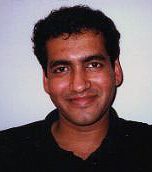
M.V. Ramana
M. V. Ramana is currently at the Program on Science and Global Security, Princeton University.
In this feature we present one of the most popular ragas of Carnatic music – Kalyani. That was Karaikurichi Arunachalam.
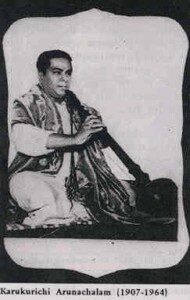
Karaikurichi Arunachalam
Kalyani is the 65th Melakarta raga, equivalent to the Hindustani raganga raga Kalyan [1]. In the older Venkatamakhi scheme, it was called Santha Kalyani. In the more modern scheme of Govinda, it is called Mecha Kalyani. It is a sampoorna raga and has a symmetrical arohana and avarohana using the chatusruti rishabham (r2), antara gandharam (g3), prati madhyamam (m2), chatusruti dhaivatam (d2) and kakali nishadam (n3) [2]. As Prof. Sambamoorthy notes, the raga “can be sung at all times, but the effect is decidedly better when sung in the evening…On account of the presence of tivra svaras in this raga, it is very useful for being sung at the commencement of concerts. The requisite musical atmosphere is soon created.” [3] (In Tamil, one would say kaLai kattum.)
All the swaras in the raga are raga chhaya swaras (important notes), and each of them can be adorned with gamakas. Alapanas typically start with the panchama or gandhara and commence with phrases like p m g r s r or g m p m g r s r. One also hears alapanas that commence with the upper shadja. According to Subbarama Dikshitar, the rishabha and the gandhara are jiva swaras [4]. However, judging by most compositions (including varnams) and other improvisational renditions, the nishada is a very prominent note too, and is often used as a nyasa swara. Thus, in practice, uttaranga sancharas dominate alapana/neraval.
Singing the raga, by omitting the shadja and/or panchama, gives Kalyani a special flavor. This can be heard in almost every recording featured. Janta (pair) swara combinations like r r g g m m d d n n and datu swara prayogas (phrases wherein intermediate notes are skipped deliberately) like n g” r” n d n r” n d m and g n d m g r are prominent. For example, the charanam of the varnam vanajakshi in ata talam (recording below) features janta swara patterns. The third chittai swara features datu swara patterns. Phrases like n d m g r and g” r” n d m g r which involve orikkai, a variety of gamaka wherein there is a momentary flick to a higher or lower tone at the end of the principal note (e.g., the former phrase is really (s”)n (n)d (p)m (m)g (g)r ), also add a special flavor to the raga. Some characteristic phrases of Kalyani are:
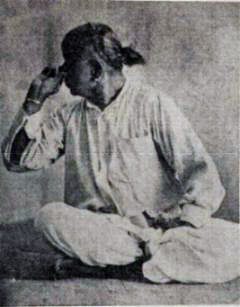
Ariyakudi Ramanuja Iyengar
r g r n_, d_ n_ d_ g r s n_ d_
n_ r g r s, g m p (m)g- r s
r n_ g r, p m g r s r
Typically, the rishaba is used as a nyasa swara in avarohi sancharas, as seen above. This should be contrasted with the treatement of the gandhara as a nyasa swara.
r g, s r g, n r g, g m pm g, g m p (m)g
p m g m p, p m n(d) p, p n d p, g n d p,
g n d m g r g m p, s” n d n p
At times the dhaivata is stressed as in p s” (n) d – p m g, g n d – p.
p (n)d n, p (n)d (s”)n, p (n)d (r”)n, n g” r” n.
The approach to the tara stayi shadja is usually through phrases such as:
p d n s”, m p d n s”, (s”)n d s”, g m d n s”, n s” g” r” s”, s” n r” s, s” n g” r” s”.

Tiger Varadachariar playing Kabbadi
The gandhara is often oscillated to g(r) or (m)g. The common phrase (pm)g – (m)(g)r illustrates the different tonal variations of the gandhara. The same is true of the nishada which assumes different shades depending on its proximity to the dhaivat (e.g., p (d) n, p (n)d n) or to the tara stayi shadja (e.g., (s”)n, (r”)n). These can be discerned in the recordings featured below.
The remainder of this article can be divided roughly into four sections. In the first section, we present the lakshana aspects of the raga as illustrated by padams and varnams. In the following two sections, lakshya aspects as seen in neraval/swara and alapana/tanam are presented. In the final section, we provide a brief description of the raga Yamuna Kalyani.
Kalyani is a major raga and is capable of being used in practically any kind of composition [5]. From the common gitam taught to beginners of Carnatic music – kamalajatala, to complicated kritis, ragam-tanam-pallavis, padams and javalis, Kalyani occupies a special place in modern Carnatic music. In a recent exhaustive compilation, Lakshman Ragde [6] estimates at least 700 compositions (including various musical forms) set to the raga Kalyani. This status of Kalyani is proof of the tremendous evolution of Carnatic music during the 18th and 19th centuries.
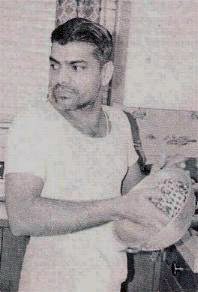
K. V. Narayanaswamy always
cooks up something interesting
Venkatamakhi in his Caturdandi Prakasika (ca. 1620 CE) dismissed it as “Turuska” (Turkish) and considered it unsuitable for three of four musical forms that he described in his treatise – gita, thaya and prabandha. He did not specify if it was suitable for alapa [7]. Another scale similarly described as turuska corresponds to the raga Todi. In his doctoral dissertation, Prof. Viswanathan notes that “neither raga seems to have particularly well known in South India before the seventeenth century, which fact seems to support the likelihood of Middle-Eastern origins.” [8]
From the above, it appears that the Kalyani scale has its origins in the North. The contours of the raga Kalyani were shaped by composers like Kshetragna (1600-1680) [9], who composed over 20 padas in this raga. Remarkably, these were composed within half a century of Venkatamakhi’s description, and these compositions show how borrowed scales can be adapted into an evolving musical system. In the first clip, we present Charumati Ramachandran singing one of the most popular of these padas, iddari sanduna [10].
In her demonstration, Charumathi makes several important observations. The (musical) format of the padam is suited for sangatis laden with karvais (pauses) and gamakas, rather than faster paced ornamentation such as the brika. The padam, being a forerunner of the kriti, influenced the evolution of the kriti. Thus, many of the prayogas heard in this Kalyani padam can be heard in the clips featuring neraval/swara/alapana/kriti. Accompanied by M. S. Anantharaman on the violin and Neyveli Narayanan on the mridangam, Charumathi Ramachandran sings the Kalyani padam iddari sanduna. Sangeetha Sivakumar provides vocal support.
We move on to the varnam, which is yet another musical form that lays the foundation for manodharma sangeetha. The first clip features the classic Kalyani varnam in ata tala, vanajakshi. Pallavi Gopala Iyer, one of the early composers of varnams and a senior contemporary of the trinity, authored this varnam the late 18th century [11]. As mentioned earlier, Kalyani can be used with great effect as the first piece in a concert.
Ariyakudi Ramanuja Iyengar [12], who was largely responsible for the present concert format, used this to his advantage, and often began his performances with this varnam. The following is an excerpt from a concert commemorating that veteran vocalist’s 75th birthday. Lalgudi Jayaraman accompanies him on the violin and Umayalpuram Sivaraman plays the mridangam. A few rounds of brisk swaraprastara follow the varnam.
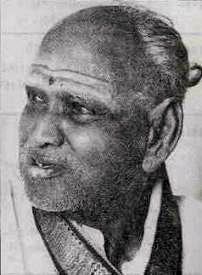
Turaiyur Rajagopala Sarma
Another classic varnam in Kalyani, often taught to beginners, is vanajakshiro, in adi tala. It is said that Pandit Ratanjankar [13] was so impressed with the varnam as a musical form that he composed a few. One such composition is ganesam vande in Yaman, which was inspired by the Kalyani varnam vanajakshiro. This varnam was composed by Ariyakudi’s guru, Ramanathapuram (Poochi) Srinivasa Iyengar.
Keeping within the same musical family, we present K. V. Narayanaswamy singing the adi tala varna, vanajakshiro. T. N. Krishnan accompanies him on the violin and Palghat Raghu plays the mridangam in this concert, an excerpt from AIR’s national program of music.
A more recent varnam is Tiger Varadachariar‘s karunai kadalE. The pallavi and muktayi swaras are largely centered on gandhara and shadja varja prayogas, as evidenced by this recording of Vidya Shankar. Mannargudi Easwaran accompanies her on the mridangam.
Before we proceed to the next section on lakshya aspects, we offer two clips from old 78 rpm recordings as an interlude. The first features a Tamil song, vELai arinthE solluvAi, sung by Turaiyur Rajagopala Sarma [14].
Listen to the golden voice of Tamil drama, senkOttai singam S. G. Kittappa [15] singing Thyagaraja‘s amma ravamma.
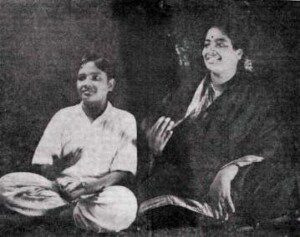
D. K. Pattammal and D. K. Jayaraman
In this section, we present Kalyani as handled in kritis. All too often, one forgets that the primary aim of a kriti is to serve as a blueprint for the raga and as a vehicle for raga delineation. We present two clips where the artistes (M. D. Ramanathan, Madurai Mani Iyer) turn small kritis of Thyagaraja into a major presentation of the raga Kalyani.
In the first of these two, M. D. Ramanathan (MDR) sings a relatively uncommon kriti, bhajana seyave. The listener will note that the kriti rendition is a minor part of the complete presentation. The manodharma of the artiste turns the neraval and swara portions into a substantial treatment of the raga. Also note how MDR uses the nishada in the beginning of the charanam (nada pranava) to launch his neraval (around 1:45 into the clip).
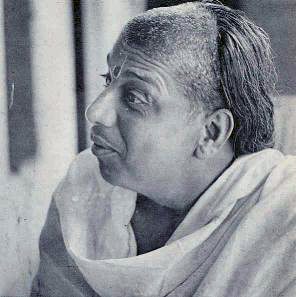
M. D. Ramanathan
A popular kriti of Thyagaraja is vasudevayani from the opera Prahlada Bhakti Vijayam. Mani Iyer prefaces the kriti with an alapana. The kriti starts at the tara stayi shadja and proceeds downwards. Accordingly, Mani Iyer structures his alapana the same way. It is instructive to note how the alapana moves from the uttaranga to the poorvanga portions (about 5 minutes into the clip).
The kriti vasudevayani followed by neraval and swaram [16].
It is not for nothing that K. V. Narayanaswamy [17] is called “neraval” Narayanaswamy by the cognoscenti, as this clip shows. Here, he sings Dikshitar‘s bhajare re chitta and the anupallavi is taken up for neraval. Aspiring musicians would do well to note the poise and balance in this exposition. The recording is an excerpt from a live concert.
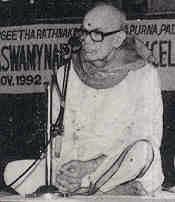
Sandhyavandanam Srinivasa Rao
Sandhyavandanam Srinivasa Rao presents another version of the same kriti in the following clip. His version is closer to that given in the Sangeeta Sampradaya Pradarshini. A. Kanyakumari accompanies him on the violin and Mannargudi Easwaran plays the mridangam in this recording from an AIR concert. Since one of our names features prominently in this kriti, we had no option but to present it in its entirety.
While Kalyani is capable of leisurely elaborate treatments, as Dikshitar‘s composition illustrates, it also shines in fast paced songs with rhythmic flourishes – kritis in tisra nadai, talas with unusual eduppus, etc. This is exemplified in Syama Sastry‘s masterpieces talli ninnunera and birana vara (whose tune also has an alternate set of Sanskrit lyrics – himadri suthe).
Tarangambadi Panchanada Iyer followed the same trend in the popular biranabrova ite. We present D. K. Pattammal and D. K. Jayaraman singing Syama Sastry‘s birana vara, followed by a rather elaborate swara prastara. The song is set to adi tala in tisra nadai, which gait is eminently suitable for neraval and swara prastara. This recording is an excerpt from a live concert in Europe. Anantakrishnan plays the violin and I. Sivakumar plays the mridangam in this concert.
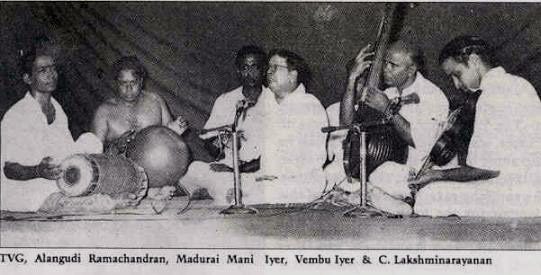
Thyagaraja has also exploited this potential of Kalyani through songs like rama nivadu and amma ravamma. We present excerpts of the latter kriti (set to khanda chapu tala) sung by Ramnad Krishnan. We draw the listener’s attention to his swaraprastara, particularly the patterns lasting for one avartanam (about 4 minutes into the clip).
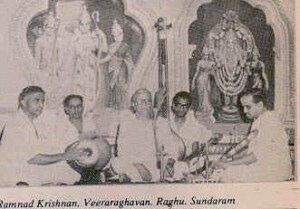
Ramnad N. Krishnan
We now move on to the next section, which features recordings from expositions of Kalyani in ragam, tanam and pallavi (RTP). Traditionally, the alapana of a raga in the RTP section proceeds in three phases. In the first, the artiste presents a quick sketch of the raga. In the second section, the poorvanga is explored and the final section is devoted to the uttaranga and the descent to the madhyama stayi. Kalyani, by virtue of its expanse is a favorite choice for RTP and there are several excellent RTP recordings. We present a few samples in this section.
In the first clip, T. M. Thyagarajan (TMT) establishes the opening movements of Kalyani.
The second clip features excerpts from an expansive alapana by M. L. Vasanthakumari. Note some scintillating movements around the nishada (about 8 minutes into the clip). Tiruvallur Subramaniam accompanies her on the violin.
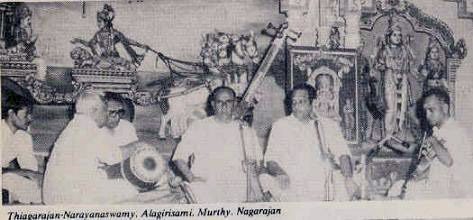
T. M. Thyagarajan
The alert listener would have recognized some of the phrases in TMT’s alapana appearing in the tara stayi of MLV’s exposition (10 minutes into the clip). Both artistes had a mutual respect for the other’s music and were influenced by the music of G. N. Balasubramaniam (GNB). Kalyani was a favorite of the latter and there are several recordings of his Kalyani RTP. An elaborate tanam is presented here. First, however, we present the closing movements of his raga exposition. On the violin, is Nellai Mani. The recording is an excerpt from a live concert in Kallidaikurichi, and GNB says at the end of the alapana, “…a modest attempt in the presence of so many periyavAL (guNis) in the audience…” Note the r d r” prayoga (3:20) as also the movements skipping shadja and the panchama (between 6:45 and 7:10).
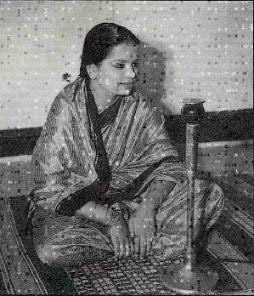
M. L. Vasanthakumari
GNB uses the gandhara as the nyasa swara extensively in the tanam that follows.
Finally, we present a pallavi sung by Voleti Venkateswarlu in Kalyani. The pallavi is parama dayakara varasugunalaya sri ramachandra – sita manohara charanu charanu and a cursory count of the syllables establishes the tala as misra jati tripuda (11 aksharas or 44 matras). The pallavi is elegantly constructed in decreasing counts (paramadaya = 6, karavara = 5, suguna = 4, laya = 3, sri = 2) before the aruti (the first half of the tala cycle) and increasing counts (sita = 4, manohara = 5, charanucharanu = 6) after the aruti.
Yamuna Kalyani
We conclude this feature with a brief note on Yamuna Kalyani.
The modern version of this raga is akin to Yaman Kalyan of the Hindustani idiom. Subbarama Dikshitar classifies the raga as bhashanga and desiya. It is a sampoorna raga and the shuddha madhyama (M) appears in vakra prayogas in the avarohana such as g M r and g M g r s. A nominal arohana/avarohana, according to Sundaram Iyer [18] is given by:
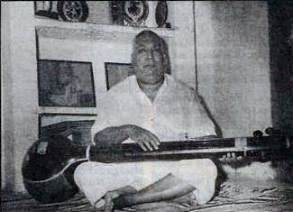
Voleti Venkateswarlu
s r g m p d n s” – s”n d p m g M r s
In his treatise, Raganidhi, Subba Rao [19] notes that there are two versions of this raga. According to him, the second does not employ the shuddha madhyama. It skips the nishada and the arohana/avarohana is s r g p m p d s” – s” d p m s g r s. We have not heard this version in practice. Perhaps because the scope of the raga is limited, it is often rendered in madhyama sruti [20]. This seems to enhance the raga’s evocativeness.
In the first clip illustrating Yamuna Kalyani, we present M. S. Subbulakshmi singing bhavayami gopala balam.
T. R. Subramaniam‘s excellent rendition of Thyagaraja‘s haridasulu vedale follows. A succint delineation of the raga precedes the kriti. The way the dhatu of the anupallavi/charanam segues into the pallavi, is Thyagaraja at his best.

M.S. Subbulakshmi
Yamuna Kalyani is inextricably associated with the piece krishna nee begane, which in turn brings T. Balasaraswathy to our minds. In the final clip of this feature, we present Bala’s rendition of krishna nee begane in Yamuna Kalyani. V. Thyagarajan accompanies her on the violin and T. Viswanathan plays the flute.
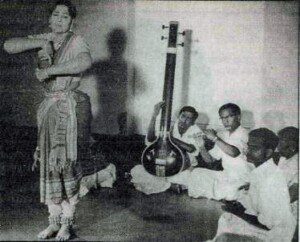
T. Balasaraswathi and T. Viswanathan
References
[1] See accompanying article on Kalyan by Rajan P. Parrikar.
[2] We use standard notation. Throughout this article, we shall use lower case letters for all swaras, as there is no ambiguity.
[3] P.Sambamoorthy, South Indian Music, Book III (The Indian Music Publishing House, Madras, 1973), p. 397.
[4] Subbarama Dikshitar, Sangeeta Sampradaya Pradarshini (Madras: The Music Academy, 1977), p. 1124.
[5] S. Rajam, Sruti, 21, 51 (1986).
[6] See Alphabetical Index of Karnatak Songs and the accompanying CD, The Ultimate Index by Lakshman Ragde.
[7] See, for example, T. Viswanathan, Raga Alapana in South Indian Music (Ph. D. Dissertation, Wesleyan University, 1974), p. 70.
[8] ibid. It should be noted that there is no consensus on this issue. Some scholars opine that these scales (Kalyani and Todi) were indeed known to the sangam Tamils as the nishada and dhaivata murchanas of Harikambodi. However, since the yAzh that accompanied the voice was usually seven stringed, these ragas were not realized in practice, and were only of theoretical interest.
[9] For biographical sketches of pre trinity (Syama Sastry, Thyagaraja and Muthuswami Dikshitar) composers, see, for instance, https://www.geocities.com/vipanchee/pretri.htm
[10] We direct those who are interested in the lyric to https://www.geocities.com/CollegePark/5409/iddari_sanduna.htm
[11] S. R. Janakiraman attributes this varnam to Mulavattam Rangasami.
[12] https://narada.org/ariyakudi/index.shtml
[13] https://music.calarts.edu/~bansuri/snratanjankar.html
[14] A disciple of Namakkal (Pallavi) Narasimha Iyengar, Turaiyur Gopu (as he was called) was a multi faceted artiste. In addition to being a vocalist, he was a Harikatha exponent, an actor, and taught music at Kalakshetra. He was called “pala kural mannar” (lit. king of many voices). Once, Chembai Vaidyanatha Bhagavathar could not perform during a recording session and asked Turaiyur Gopu to mimic him. To date, this recording (aabatpAndavanE) is attributed officially to Chembai. Similarly, the song bhajanai seyvOm in the sound track of the film mAyaprapancam (starring M. K. Thayagaraja Bhagavatar), attributed to MKT was, in fact, sung by Turaiyur Gopu.
[15] To quote P. V. Subramaniam (Subbudu), “…The late S. G. Kittappa, for many years the lone star of the Tamil stage had for an accompaniment his brother, Shri S. G. Kasi Iyer, on the Harmonium. His rich, sonorous and pliable voice could be matched by notes which could be coaxed only out of the Harmonium. All other instruments were unequal to the vocal challenge. To dismiss Kittappa as a stage singer would be doing injustice both to his music and to his artistic genius. It is said that the great composer Gayaka-sikamani Muthia Bagavatar used to test his own competence with Kittappa’s vocal chords. The flashes of musical variations with which Kittappa illuminated Karnatak music compositions, classical, semi-classical and light, attracted admiration and emulation by great stalwarts like Violin Govindaswamy Pillai, Nadaswaram Rajaratnam Pillai and Ariyakudi Ramanuja Iyengar. These masters were regular first-nighters at his stage shows.”
[16] Sanjay Subrahmanyan talks about his fascination for Mani Iyer’s neraval and swaram in: https://www.chennaionline.com/musicseason2k/features/maduraimani.asp
[17] See https://www.narada.org/kvn/index.shtml
[18] A. Sundaram Iyer, Sri Dikshita Kirtana Mala, Music Books Publishers, 1976.
[19] B. Subba Rao, Raganidhi, Music Academy, Madras, 1984.
[20] Another example that comes to mind readily, is the raga Nadanamakriya.
